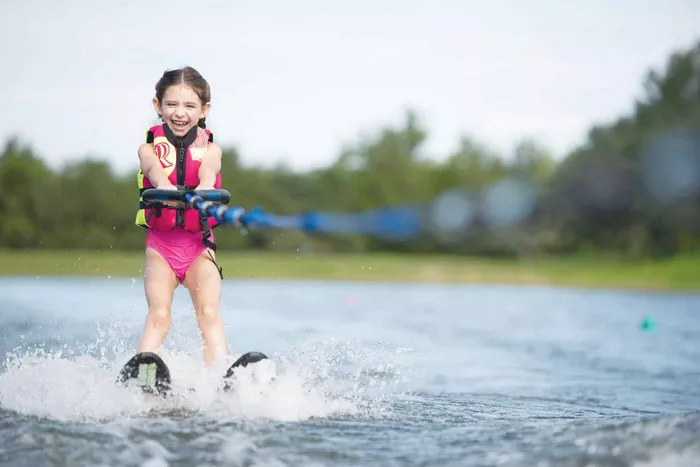Water skiing is an exhilarating water sport enjoyed by millions around the world. Whether gliding gracefully across calm lakes or slicing through the waves of the open ocean, water skiers rely on a crucial piece of equipment: their skis. The design and construction of water skis play a vital role in the performance and enjoyment of the sport. In this article, we delve into the materials used in crafting water skis, exploring their composition, characteristics, and impact on the skier’s experience.
The Evolution of Water Ski Materials
Water skiing has a rich history dating back to the early 20th century, but it wasn’t until the mid-20th century that modern materials revolutionized ski design. Traditionally, water skis were crafted from wood, typically mahogany or ash, offering a balance of buoyancy and flexibility. While wooden skis provided adequate performance for recreational skiing, they were heavy and prone to warping when exposed to water for extended periods.
The introduction of fiberglass in the 1950s marked a significant advancement in water ski technology. Fiberglass offered superior strength-to-weight ratio compared to wood, allowing for lighter and more durable skis. This transition sparked an era of innovation as manufacturers experimented with new shapes and designs to optimize performance.
In the following decades, the development of composite materials further pushed the boundaries of ski design. Carbon fiber, Kevlar, and other high-performance composites allowed for even lighter, stiffer, and more responsive skis. These materials revolutionized the sport, enabling athletes to achieve greater speed, agility, and control on the water.
Modern Water Ski Construction
Contemporary water skis are typically constructed using a combination of fiberglass, carbon fiber, and foam cores. Each material contributes unique properties to the ski, resulting in a balanced blend of buoyancy, strength, and responsiveness.
1. Fiberglass:
Fiberglass remains a staple in water ski construction due to its excellent strength-to-weight ratio and affordability. Layers of fiberglass fabric are impregnated with resin and molded into the desired shape, forming the outer shell of the ski. Fiberglass provides durability and stiffness, crucial for maintaining shape and stability under high speeds and dynamic water conditions.
2. Carbon Fiber:
Carbon fiber is renowned for its exceptional stiffness and strength, making it a popular choice for high-performance water skis. Carbon fiber layers are strategically integrated into the ski’s construction to enhance torsional rigidity and energy transfer, resulting in precise edge control and responsive turns. While more expensive than fiberglass, carbon fiber skis offer unparalleled performance for competitive skiers seeking maximum speed and agility.
3. Foam Core:
The core of a water ski plays a critical role in its buoyancy and flex characteristics. Foam cores, typically made from lightweight polyurethane or PVC foam, provide the internal structure of the ski. These cores are carefully shaped and laminated with fiberglass or carbon fiber layers to create a durable, responsive platform for the skier. Foam cores contribute to the ski’s buoyancy, allowing it to float on the water’s surface while providing enough flex to absorb bumps and vibrations for a smoother ride.
The Influence of Design and Shape
In addition to materials, the design and shape of water skis significantly impact their performance and handling on the water. Manufacturers employ advanced engineering techniques and computer-aided design (CAD) software to optimize ski geometry for various skiing styles and skill levels.
1. Length:
The length of a water ski affects its stability, maneuverability, and speed. Longer skis offer greater stability and buoyancy, making them ideal for beginners and recreational skiers. Shorter skis, on the other hand, are more maneuverable and responsive, suited for advanced skiers and trick skiing.
2. Width:
Ski width plays a crucial role in flotation and stability. Wider skis provide more surface area, enhancing buoyancy and making it easier to stay afloat, particularly for heavier skiers or those skiing in rough water conditions. Narrower skis offer less drag and greater maneuverability, ideal for slalom skiing and carving tight turns.
3. Rocker:
The rocker refers to the curvature of the ski from tip to tail. Skis with a pronounced rocker have a more rounded shape, allowing for smoother turns and better performance in choppy water. Conversely, skis with minimal rocker have a flatter profile, providing increased stability and speed on calm water.
Performance and Skill Level
The choice of water ski materials, design, and setup ultimately depends on the skier’s performance goals and skill level. Recreational skiers may prioritize comfort, stability, and ease of use, opting for fiberglass skis with moderate rocker and wider profiles. Intermediate skiers seeking to improve their skills may gravitate towards carbon fiber skis with adjustable bindings and versatile fin setups, offering a balance of performance and adaptability.
For advanced and competitive skiers, high-performance carbon fiber skis with aggressive rocker profiles and precision-tuned fin configurations are essential for pushing the limits of speed and agility. These skis offer lightning-fast response, razor-sharp edge control, and maximum energy transfer, enabling athletes to tackle slalom courses, execute aerial maneuvers, and achieve podium-worthy performances.
Conclusion
Water skiing is a dynamic and exhilarating sport that relies on the synergy of skill, technique, and equipment. The evolution of water ski materials, from traditional wood to modern composites, has transformed the sport, enabling athletes to push the boundaries of performance and innovation.
By understanding the composition, design, and performance characteristics of water skis, enthusiasts can make informed decisions when selecting equipment tailored to their individual preferences and skill levels. Whether gliding across serene lakes or challenging the waves of the open ocean, the right pair of skis can elevate the water skiing experience to new heights of excitement and enjoyment.

